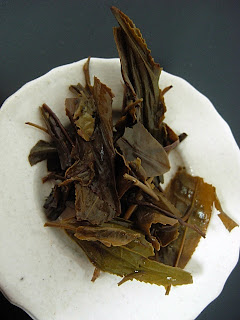
The dry leaves are a hodge podge of browish greens, light and dark browns mixed in a loosely packed cake with light brown stems. The smell of this tea is indubitably one of its high points as it emits the strong odour of fine sweet tobacco that is unfortunately lost in its infusion.
Instantly, sour and an uninviting bitterness rush to conqueror the buds of one's tongue. This is almost enough to spit the tea across the room. But before one can act on impulse this tea transitions into an excitingly pleasurable bitter that stagnates on the roof of ones mouth and front of ones tongue for quite a time after. The flavors of sweet hay, raw sugarcane, and butter fight for attention over astringency. After about the fourth or fifth infusion, the intensity starts to wane as the major flavour elements have noticeably dropped off and slowly give way to soft astringency and sweet yellow water.
The qi of this tea is very simple which shows telltale signs of its youth. It can mainly be felt in ones mouth and slightly stimulating the area below ones tangen.

This tea presents a dichotomy of elements that forces even the most unspoken tea drinker to contemplate what had just taken place on their pallet. Perhaps this is the reason monks have enjoyed this kind of tea for hundreds of years. And perhaps this is the reason why I take such joy in drinking it today.
Peace.



3 comments:
matt-Can you chat off-line? Here is my contact:
contact@hsuandassociates.com
Thanks-Tok
Yes. I'll contact you soon.
Peace.
Hey Matt,
Nice to see another blog :)
I have a question for you too -- email me at marshaln at gmail?
Post a Comment